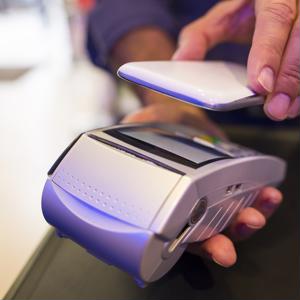The payment technology of the future. Hint: it's not EMV

Although EMV technology has been around for decades, its relatively recent introduction to the U.S. (and the ensuing liability shift) has brought the new credit card technology to the forefront of American merchants' minds. While EMV transactions and compliance have come to dominate the merchant payment conversation as of late, another, more innovative payment technology has positioned itself to eclipse EMV as the new future of consumer payment technology: NFC.
To understand how this shift could take place, let's first take a moment to lay out the difference between these two payment methods.
EMV, which stands for "Europay, MasterCard, and Visa," is the technology behind transactions between a chip-enabled credit card and an EMV-enabled payment terminal or ATM. Chip cards have become the new standard in America because of their ability to better protect users from having their credit card information stolen than their magnetic strip predecessors.
NFC, or Near Field Communication, is a technology that allows enabled devices to share information over a Bluetooth-like, low power, contactless connection. So far, NFC has most commonly been used on smartphones, turning them into digital wallets capable of securely transmitting payment data to certain retailer terminals.
One indication NFC is poised for a boom in popularity is that it has become more popular with the younger generation, suggesting it will eventually outpace EMV cards as the leading mode of consumer payments. According to the the Federal Reserve's "Consumers and Mobile Financial Services 2015" report, 28 percent of smartphone users used mobile payments last year. The addition of mobile payment offerings from major players like Apple, Google (Android), Samsung, Capital One and Chase in suggest that 2015 totals will be even higher. When looking only at younger users, aged 18 to 24, the percentage of mobile payers jumps to 42, more than double the number of those who reported to use EMV credit cards.
Another advantage NFC has over EMV is its convenience. When consumers first started "dipping" their chip cards instead of swiping strip cards, they were taken aback at how long the process took. While only a difference of a few seconds, it has proven to be long enough to prompt some consumers to reach for different methods of payment. With their phones already in their hands and mobile payments taking only a moment to make, NFC was a logical next step. NFC payments could get even more convenient with the technology industry's new focus on wearables, too. Starting this year with the Apple Watch, wearable tech could take another massive leap into the consumer payments space over the next few years. According to Wearable.com, MasterCard is looking into partnerships that would embed NFC payment technology into everyday items, such as wallets, rings and even jackets to make paying even more convenient.
Above all, however, one of the most impactful reasons NFC could become the new go-to method of payment is because it can be more secure than EMV options. Although EMV made significant strides over magnetic strip cards in terms of protecting consumer data, NFC's three-tiered security system is still more robust. Leveraging biometrics, secure element chips and tokenization, NFC payment options can be completely unique to a specific device and an individual user in a way no prior payment method has been able to achieve.
At Vantage, we're experienced in helping merchants determine which payment processing solutions are right for their business models. Contact us today to learn more about our solutions, ask a question or schedule a consultation.